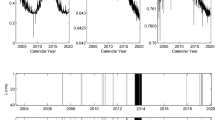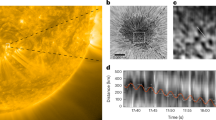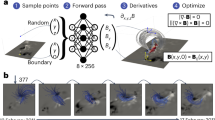Abstract
A NEW instrument, the solar magnetograph1, has been developed for measuring and recording weak photospherio magnetic fields. With it, more than 450 magnetograms showing the distribution, intensity and polarity of weak fields (greater than 0.3 gauss) on the sun have been obtained over a two-year period including the recent minimum of solar activity2. Most of the large-scale features of the magnetic pattern show a certain regularity; but there are pronounced random variations. There is also a partially resolved fluctuating fine structure showing changes of the order of 0.5 gauss in 30 min.
This is a preview of subscription content, access via your institution
Access options
Subscribe to this journal
Receive 51 print issues and online access
$199.00 per year
only $3.90 per issue
Buy this article
- Purchase on SpringerLink
- Instant access to full article PDF
Prices may be subject to local taxes which are calculated during checkout
Similar content being viewed by others
References
Babcock, H. W., Astrophys. J, 118, 387 (1953).
Babcock, H. W., and Babcock, H. D., Astrophys. J. (in the press).
Cowling, T. G., “The Sun”, 568 (Kuiper, edit., Univ. of Chicago Press, 1953).
Hale, Ellerman, Nicholson, and Joy, Astrophys. J., 49, 153 (1919).
Bartels, J., Terr. Mag. Atm. Elec., 37, 48 (1932).
Minkowski and Greenstein, Astrophys. J., 119, 238 (1954).
Chapman and Ferraro, Nature, 126, 129 (1930).
Mon. Not. Roy. Astro. Soc., 107, 211 (1947).
Author information
Authors and Affiliations
Rights and permissions
About this article
Cite this article
BABCOCK, H., BABCOCK, H. The Sun's Magnetic Field and Corpuscular Emission. Nature 175, 296 (1955). https://doi.org/10.1038/175296a0
Issue date:
DOI: https://doi.org/10.1038/175296a0



